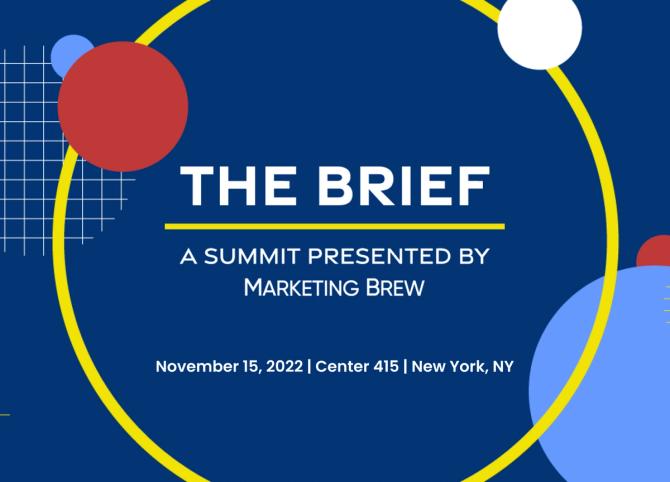Happy Thursday. Say hello to Kenvue, the new name of the company that Johnson & Johnson intends to encompass its consumer-health brands, which include Band-Aid and Tylenol.
In today’s edition:
—Alyssa Meyers, Kelsey Sutton, Minda Smiley
|
|
Illustration: Dianna “Mick” McDougall, Photos: Getty Images
As product placement overtakes your favorite TV shows and movies, the marketing tactic could also infiltrate a seemingly unlikely medium: podcasting.
Product placement often involves characters on screen sipping from cans of Coke, sporting Nike kicks, or scarfing down KFC. But podcasting lacks visual cues, making it tricky to naturally insert brands into content without naming them outright.
- QCode, a podcast network known for its scripted-fiction podcasts led by actors like Rami Malek, Gina Rodriguez, and Demi Moore, is working on figuring out how.
- “We think about QCode as an entertainment company,” Steve Wilson, QCode’s chief strategy officer, told Marketing Brew.
- Since product placement is so entrenched in film and TV, “it would only be natural that this would become part of the podcast landscape as the world of podcasts continues to grow.”
Looking ahead: While QCode is still in the early days of experimenting with product placement—known at the network as “in-universe brand creative” in its current form, according to head of sales and brand partnerships, Rich Eiseman—brands including Bud Light, Johnnie Walker, and HEB have already permeated a few of its shows.
Click here to read about how these brands have approached it.—AM
|
|
|
Psst, marketers: Been hearing whispers about customer marketing lately? Executives are rapidly buying in and investing in customer marketing, with 98% of them rating it as important or very important to the success of their org.
Not to mention: Customer marketing manager is the 3rd-fastest-growing job title of all jobs in the USA.
We can see why—customer marketing gives a significant boost to every function in marketing, including demand generation, product marketing, and content.
See how this realm has matured and evolved + how you can add a customer marketer to your team with Influitive’s 2022 State of Customer Marketing Report, featuring input from 200 customer marketing and advocacy pros from 17 countries.
The secret’s out on customer marketing. Learn how it continues to deliver and how you can leverage that growth wisely with Influitive.
Download the free report here.
|
|
Fotog/Getty Images
Advertising spend came roaring back this year, but brace yourself: another slowdown is on the horizon.
The overall US advertising market, which grew 11% in the first half of 2022 to $151 billion, is expected to see a slowdown in the second half and into 2023, according to a new forecast from Magna, which tracks media investments.
-
Overall, non-cyclical ad spend (i.e., all the ad spend not related to elections or programming like the World Cup) will slow down to around 6.6% growth in the second half of the year.
- In 2023, Magna expects total ad revenue to grow 4.8%, down one percentage point from the firm’s prior forecast.
The slowdown will be driven primarily by a pullback in advertising spend in verticals facing economic headwinds, like consumer packaged goods, restaurants, retail, and financial services like mortgage lenders.
Social woes: The fallout from Apple’s iOS changes has already put pressure on social advertising growth. By the end of the first half, social advertising only grew by 3%, and Magna expects it will end the year with only 4% growth overall. Magna expects slightly more growth—6.4%—in 2023.
Chin up: Ad revenues for the entirety of 2022 are expected to reach $323 billion this year, an increase of $29 billion from 2021, as ad formats like out-of-home, search, and digital audio see double-digit growth.
- Other bright spots include cinema (which grew by an enormous 430% in the first half of 2022 due to a theatrical comeback) and ad-supported streaming, which is expected to grow by 22% by year’s end.
 Political advertising is also set to boost ad revenues in the second half of the year, with Magna expecting political ad spend to generate $7.3 billion in incremental ad revenue.—KS Political advertising is also set to boost ad revenues in the second half of the year, with Magna expecting political ad spend to generate $7.3 billion in incremental ad revenue.—KS
|
|
Francis Scialabba
If you’re a longtime Marketing Brew reader, you might remember that we spent some time covering several aspects of in-housing last year—everything from the perks and challenges of taking creative in-house to why some major brands were bringing some media functions under their own roof.
In-housing has seemingly been on the up and up over the past decade or so. An oft-cited 2018 study from the ANA found that 78% of its members had an in-house agency that year, compared to 58% in 2013.
But that could be changing. According to a recent Digiday article, “some say the pendulum is swinging back from brands looking to build out their in-house teams to working with agencies more now,” as marketers are looking to agencies for help navigating things like Apple’s privacy changes.
Earlier this week, we asked marketers who work for brands if they had an in-house agency. More than 800 readers responded:
- 53% said they do
- 47% said they don’t
Do you think the in-housing trend is losing steam? Reply to this email to share your take. 
+1: Tripadvisor recently took in-housing a step further, announcing last week that it’s unveiling an in-house studio called Wanderlab that will do work for other brands (the San Diego Tourism Authority is its first client). It’s not necessarily a novel idea: Since 2017, Liberty Mutual has had an internal agency that does work for outside clients.
|
|
|
Bring your brand into frame. Ready to showcase your brand and attract new audiences? Turn to video. And for video marketing that’s built to impress and engage, turn to Vimeo. Learn how Vimeo can help you bring cinematic quality to your next campaign, demo, or virtual event when you click here.
|
|
Francis Scialabba
There are a lot of bad marketing tips out there. These aren’t those.
MultiverseMetaverse: How to succeed at building your brand in Web3.
Ad fail: Why your Facebook ads might not be reaching your target audience and how to solve the problem.
Two is better than one: This TikTok guide offers tips on how to craft a paid and organic strategy on the platform.
Stream on: Tubi’s 100% ad-supported streaming platform is built to serve audiences and advertisers. See why over 56m users choose Tubi every month—and how your brand can reach them. Learn more.* *This is sponsored advertising content.
|
|
Have you been wondering how HBO is crushing the modern marketing game (any House of the Dragon stans)? Or how Duolingo’s Duo the owl became a storytelling sensation on TikTok? And really, how the heck has Vans managed to transcend the generations and stay part of the cool crowd, even as our beloved skinny jeans get dunked on day after day?
Well, you’ll find the answer to all these questions and more (yes, much more) at the biggest Marketing Brew event yet: The Brief on Nov. 15. This jam-packed day of panels, presentations, and networking will give you strategies to implement immediately, plus the chance to interact personally with some of the best in the industry (not to mention your fellow marketing rock stars). Quick: We have advanced pricing for only a limited time, so grab your ticket here before the cost goes up!
|
|
-
Twitter sent emails to advertisers and agencies letting them know it ran ads on profiles “soliciting or selling child sexual abuse material,” according to Insider.
-
State Farm CMO Rand Harbert is stepping down after 12 years and will be replaced by current senior VP for agency and marketing, Kristyn Cook.
-
CMO pay at “growth-stage digitally focused companies” has been rising more quickly than for other execs in the past year, according to consultancy and executive search firm Eastward Partners.
-
Burberry has named Daniel Lee its chief creative officer.
|
|
Kantar published the latest version of its sustainability study, called “Who Cares, Who Does,” and found that for the first time in the four years it’s been conducting the research, the number of “eco actives” dropped while the number of “eco dismissers” rose. Here’s what that means.
Eco actives: This is the group “for whom reducing their waste is a firm habit,” wrote Natalie Babbage, global director for Kantar’s LinkQ solution. They’re also “a huge market that brands are under-servicing,” according to the report.
- The share of eco actives dropped by 4% globally, from 22% in 2021 to 18% in 2022.
- Still, Kantar predicts growth on this front over the next five years.
- Optimistically, the share of eco actives could be up to 38% by 2027. Pessimistically, it’ll only reach back to 22%.
Eco dismissers: These people “have little or no interest in the environment” and are “making no steps to reduce waste,” per Kantar.
- The share of eco dismissers rose 7% from 37% of the global population in 2021 to 44% this year.
- “Eco considerers,” who are worried about the environment but don’t act on those concerns the way eco actives do, accounted for 38% of the population this year, down three percentage points from 41% last year.
|
|
Catch up on a few Marketing Brew stories you might have missed.
|
|
|
Written by
Alyssa Meyers, Minda Smiley, and Kelsey Sutton
Was this email forwarded to you? Sign up
here.
|
ADVERTISE
//
CAREERS
//
SHOP
//
FAQ
Update your email preferences or unsubscribe
here.
View our privacy policy
here.
Copyright ©
2022
Morning Brew. All rights reserved.
22 W 19th St, 4th Floor, New York, NY 10011
|
|











